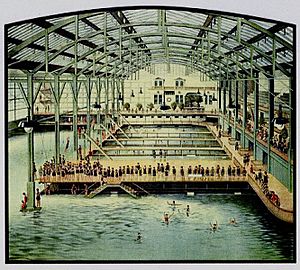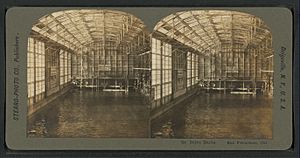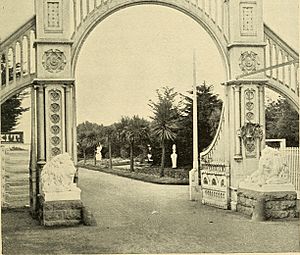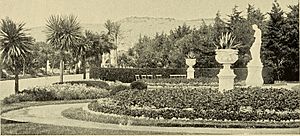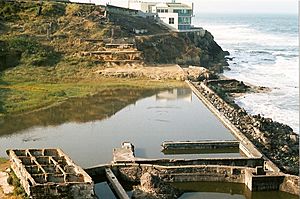Sutro District facts for kids
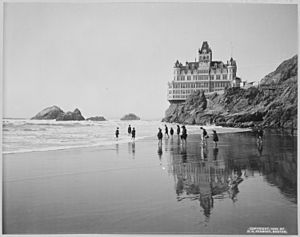
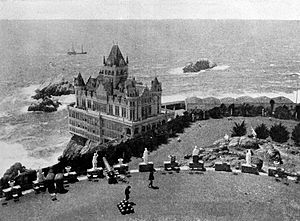
The Sutro Historic District is a special area in western San Francisco, California. It is located in the Lands End part of the Outer Richmond District. This historic district is now part of the Golden Gate National Recreation Area. The National Park Service took over its care in 1977.
This area includes many famous spots along Point Lobos Avenue. These places were first built by Adolph Sutro. He was a very rich man who made his money from silver mining. He also owned a lot of land and was once the mayor of San Francisco. The famous 49-Mile Scenic Drive goes right through this historic district.
Contents
History of the Sutro Historic District
Adolph Sutro's Vision
In 1881, Adolph Sutro bought 22 acres (about 89,000 square meters) of undeveloped land. This land was on the western edge of San Francisco, overlooking the Pacific Ocean. It offered amazing views of the Marin Headlands, Mount Tamalpais, and the Golden Gate. Sutro built his home on a rocky spot here, above the first Cliff House.
Sutro created many attractions on his land at Lands End. He wanted to make this beautiful area open for everyone to enjoy.
Sutro Heights Park: A Public Garden
Sutro Heights Park was once Adolph Sutro's private estate. He opened his large gardens to the public in 1885. People could visit and enjoy the plants and statues. In 1938, it became a city park. Later, in 1976, the City of San Francisco gave the park to the National Park Service. Now, it is part of the Golden Gate National Recreation Area.
Sutro's Aquarium: Underwater Wonders
Sutro's Aquarium opened in 1887. It was a concrete pool built in a small bay near the Cliff House. Fresh seawater flowed into it through a long tunnel. There was also a warm, glass-enclosed pool above the main one. This pool held more unusual sea creatures for visitors to see.
Sutro Baths: A Giant Swimming Pool Complex
Sutro Baths was a huge public bathhouse and swimming facility. It opened in 1894. It had six large saltwater swimming tanks. These tanks were different sizes, shapes, and temperatures. There were also many rows of seats for thousands of people to watch. A massive glass roof covered the baths. It was made from 100,000 square feet of stained glass.
The Cliff House: A Grand Building
The Cliff House was a famous building near the ocean. The second Cliff House, built in 1896, was a fancy Victorian-style palace. It looked like a grand castle.
Sutro Pleasure Grounds: A Fun Park
The Sutro Pleasure Grounds at Merrie Way was a large amusement park. It was open from 1896 to 1898. It offered many fun activities for visitors.
Easy Ways to Get There
Getting to the Cliff House used to be expensive. So, in 1885, Sutro invested in a new train line. This train, called The Cliff House and Ferries Railroad, made it cheaper and easier. It took visitors from downtown San Francisco to the Sutro Heights area.
After Adolph Sutro's Time
Adolph Sutro passed away in 1898. His daughter, Emma Sutro Merritt, then lived at the Sutro Heights estate. The gardens stayed in good shape until the early 1920s. In 1920, Sutro Heights was given to the City of San Francisco. The city promised to keep it as a free public park.
The second Cliff House burned down in 1907. A new, third Cliff House opened in 1909. It was built in a simpler Neoclassical style. This Cliff House did well until 1918. During World War I, places near military areas had to close. The Cliff House closed again in 1925 and did not reopen until 1937.
In 1933, the City of San Francisco agreed to take care of Sutro Heights. But not much was done to improve the gardens. After Emma Sutro Merritt died in 1938, the gardens became even more run down. During World War II, Sutro Heights was closed for safety reasons.
In 1951, the Sutro Baths were sold. They had lost many visitors during World War II. The new owner, George K. Whitney, turned the swimming tanks into a large ice skating rink. Later, in 1964, a developer bought the property. He wanted to build an apartment tower. But in June 1966, a fire destroyed the Sutro Baths. This fire stopped the plans for new buildings.
The National Park Service Takes Over
In 1976, the National Park Service took ownership of the Sutro Baths site. Today, many people visit the ruins of the baths. They explore the remains and imagine what it was like. In 1977, the National Park Service also acquired the third Cliff House, built in 1909.
The National Park Service works to protect the historic features of Sutro Heights Park. They have stored and cataloged old concrete pieces, fountains, and statues. They even made new copies of some statues, like the lions at the entrance, and put them back.
Becoming a Historic District
In 2000, the National Park Service tried to get the area listed as a historic district. This would recognize its importance on the National Register of Historic Places. While the full district listing did not happen, the Camera Obscura at the Cliff House was added to the National Register.
The Sutro Historic District Today
The Sutro Historic District is still a wonderful place to visit. It includes Sutro Heights Park and the Sutro Baths ruins. People can walk around, learn about history, watch wildlife, and have picnics. The historic Cliff House and the Camera Obscura are also still popular attractions.
The National Park Service offers programs and events at the Golden Gate National Recreation Area. These help visitors learn more about the history of this special place.


